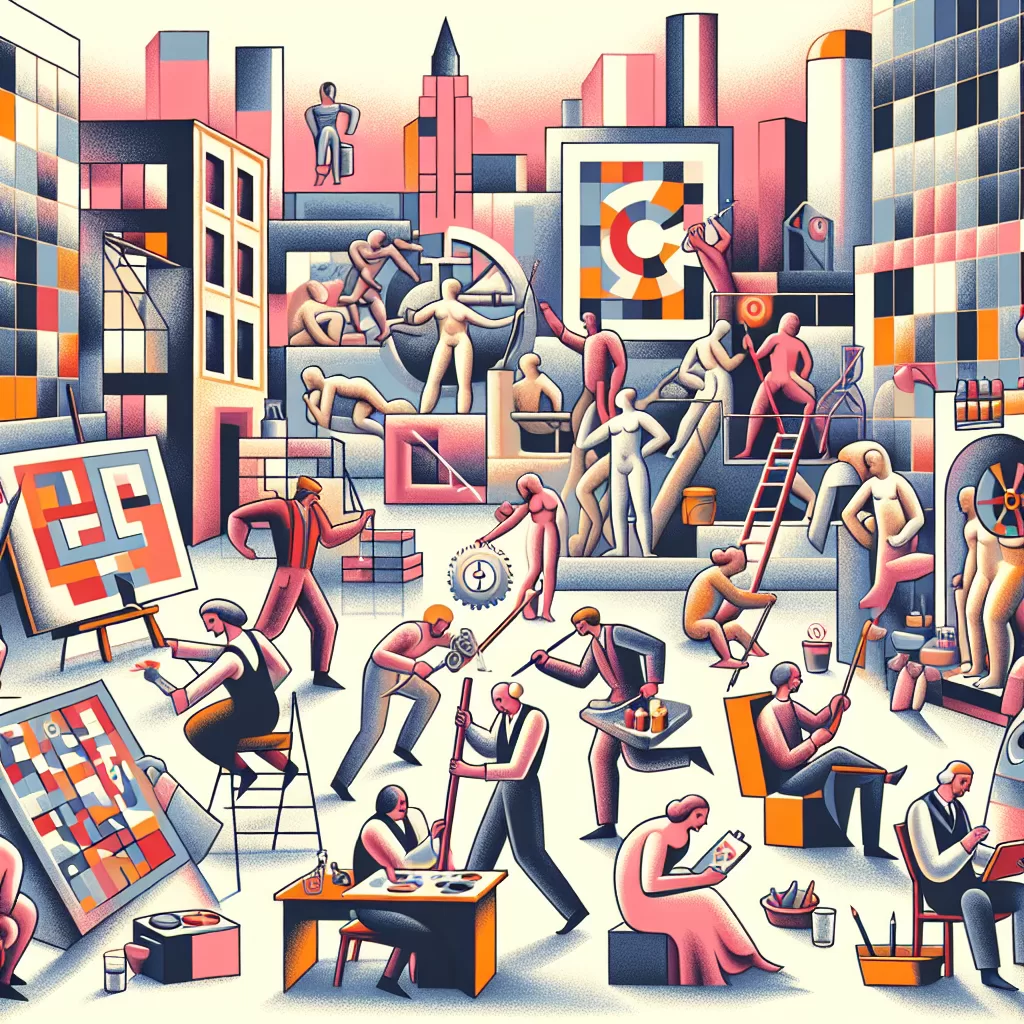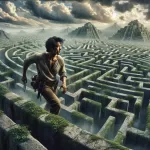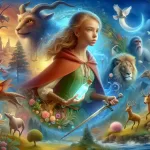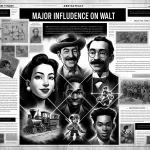-
Innehållsförteckning
- Overview of 20th Century Modernism
- Key Themes in 20th Century Modernism
- Major Characters in 20th Century Modernism Literature
- Influence of Historical Events on Modernism
- Comparison of Modernism and Postmodernism
- Notable Authors of 20th Century Modernism
- Impact of Modernism on Contemporary Literature
- FRÅGOR OCH SVAR
Part 6 of the 20th Century Modernism Quizlet Summary explores the key themes and characters that define the modernist movement in literature and art. This section delves into the innovative narrative techniques, fragmented structures, and existential themes that characterize modernist works. It highlights prominent figures such as Virginia Woolf, James Joyce, and T.S. Eliot, examining their contributions to the movement and the ways in which they challenged traditional forms of storytelling. The summary also addresses the cultural and historical contexts that influenced modernism, including the impact of World War I, industrialization, and shifts in societal norms. Through this exploration, readers gain a deeper understanding of the complexities and nuances of modernist literature and its enduring legacy.
Overview of 20th Century Modernism
The 20th century marked a significant departure from traditional artistic and literary conventions, giving rise to the movement known as Modernism. This period, characterized by a profound sense of disillusionment and a quest for new forms of expression, emerged in response to the rapid changes brought about by industrialization, urbanization, and the aftermath of World War I. As society grappled with the complexities of modern life, artists and writers sought to break free from established norms, exploring innovative techniques and themes that reflected the fragmented reality of their time.
One of the defining features of Modernism is its emphasis on subjectivity and the inner workings of the human mind. This shift is evident in the works of prominent figures such as Virginia Woolf and James Joyce, who employed stream-of-consciousness techniques to delve into the thoughts and emotions of their characters. By prioritizing individual perception over objective reality, these authors challenged readers to engage with the text on a deeper level, inviting them to experience the chaos and uncertainty of modern existence. Consequently, the narrative structure often became non-linear, mirroring the complexities of human experience and the disjointed nature of contemporary life.
Moreover, Modernism was marked by a profound sense of alienation and existential angst. Many writers and artists grappled with feelings of isolation in an increasingly mechanized world, leading to themes of disconnection and despair. T.S. Eliot’s “The Waste Land,” for instance, encapsulates this sense of fragmentation, weaving together disparate voices and images to portray a world devoid of meaning. This exploration of alienation was not limited to literature; visual artists such as Pablo Picasso and Marcel Duchamp also sought to challenge traditional aesthetics, employing abstraction and conceptual art to reflect the disorienting nature of modernity.
In addition to themes of alienation, Modernism also engaged with the idea of identity and the self. The questioning of established norms and values prompted a reevaluation of what it meant to be human in a rapidly changing world. Writers like F. Scott Fitzgerald and Ernest Hemingway explored the complexities of identity through their characters, often depicting individuals caught between societal expectations and personal desires. This exploration of identity was further complicated by the impact of globalization, as cultural exchanges began to shape artistic expression in new and diverse ways.
As Modernism progressed, it also gave rise to various sub-movements, each contributing to the broader narrative of the era. The Harlem Renaissance, for example, emerged as a powerful expression of African American culture and identity, challenging prevailing stereotypes and celebrating the richness of Black life. Similarly, the Surrealist movement sought to unlock the unconscious mind, using dream-like imagery and irrational juxtapositions to explore the depths of human experience. These diverse movements within Modernism not only enriched the artistic landscape but also underscored the multiplicity of voices and perspectives that characterized the 20th century.
In conclusion, the overview of 20th-century Modernism reveals a complex interplay of themes, techniques, and cultural shifts that defined the era. Through their innovative approaches, Modernist writers and artists sought to capture the essence of a rapidly changing world, reflecting the anxieties, aspirations, and contradictions of modern life. As we examine the works produced during this period, it becomes evident that Modernism was not merely a reaction to the challenges of its time but also a profound exploration of the human condition, inviting us to reconsider our understanding of art, identity, and existence itself.
Key Themes in 20th Century Modernism
The 20th century marked a significant departure from traditional artistic and literary conventions, giving rise to modernism, a movement characterized by a profound exploration of new ideas, forms, and perspectives. One of the key themes in 20th-century modernism is the quest for identity. As societies underwent rapid changes due to industrialization, urbanization, and the aftermath of World War I, individuals grappled with their sense of self in an increasingly fragmented world. This theme is poignantly illustrated in the works of authors such as Virginia Woolf and James Joyce, who employed stream-of-consciousness techniques to delve into the inner lives of their characters, revealing the complexities of human consciousness and the struggle for personal meaning amidst chaos.
Another prominent theme is the alienation and disillusionment experienced by individuals in modern society. The horrors of war, the rise of totalitarian regimes, and the disintegration of traditional values led many to feel disconnected from their surroundings and from one another. This sense of alienation is vividly captured in T.S. Eliot’s “The Waste Land,” where the fragmented narrative reflects the disjointed reality of post-war life. The poem’s imagery evokes a world devoid of meaning, highlighting the existential crisis faced by individuals who sought purpose in a seemingly indifferent universe. As such, modernist literature often portrays characters who are isolated, struggling to find their place in a world that appears increasingly hostile and chaotic.
Moreover, the theme of time and its perception plays a crucial role in modernist works. Modernist writers frequently experimented with narrative structures, challenging linear storytelling and instead presenting time as fluid and subjective. This is evident in Marcel Proust’s “In Search of Lost Time,” where the act of remembering becomes a central motif, blurring the lines between past and present. Through this exploration, modernism invites readers to reconsider their understanding of time, suggesting that memory and experience shape one’s identity and reality. Consequently, the manipulation of time in modernist literature serves to reflect the complexities of human experience and the often elusive nature of truth.
In addition to these themes, modernism also engages with the concept of fragmentation, both in form and content. The disjointed narratives and unconventional structures found in works by authors such as Franz Kafka and Gertrude Stein mirror the fractured nature of contemporary existence. This fragmentation is not merely a stylistic choice; it serves to convey the disarray of modern life and the difficulty of making sense of a world that defies coherence. As readers navigate these fragmented texts, they are compelled to confront the uncertainties and ambiguities that characterize the human experience.
Furthermore, the theme of innovation and experimentation is central to modernism, as artists and writers sought to break free from established norms and conventions. This desire for innovation is evident in the visual arts, where movements such as Cubism and Surrealism emerged, challenging traditional representations of reality. Similarly, in literature, modernist writers embraced new forms and techniques, reflecting the dynamic nature of the world around them. This spirit of experimentation not only redefined artistic expression but also encouraged a broader cultural shift towards embracing change and questioning established beliefs.
In conclusion, the key themes of identity, alienation, time, fragmentation, and innovation are intricately woven into the fabric of 20th-century modernism. Through their exploration of these themes, modernist writers and artists captured the complexities of human experience in a rapidly changing world, inviting audiences to engage with the uncertainties and possibilities that define modern existence. As such, modernism remains a vital lens through which to understand the cultural and artistic developments of the 20th century.
Major Characters in 20th Century Modernism Literature
The 20th century marked a significant departure from traditional literary forms and conventions, giving rise to modernism, a movement characterized by a break with established norms and an exploration of new narrative techniques. Central to this literary revolution were a host of major characters who embodied the complexities and contradictions of contemporary life. These characters often grappled with themes of alienation, existential despair, and the search for meaning in an increasingly fragmented world.
One of the most iconic figures in modernist literature is Leopold Bloom from James Joyce’s “Ulysses.” Bloom, an ordinary Jewish man living in Dublin, navigates the mundane realities of life while simultaneously engaging in profound philosophical reflections. His journey through the city on a single day mirrors the epic quest of Odysseus, yet it is steeped in the minutiae of everyday existence. Bloom’s character exemplifies the modernist preoccupation with the inner workings of the mind, as Joyce employs stream-of-consciousness techniques to reveal Bloom’s thoughts, desires, and insecurities. This narrative style invites readers to experience the world through Bloom’s perspective, highlighting the subjective nature of reality.
Similarly, in Virginia Woolf’s “Mrs. Dalloway,” the titular character, Clarissa Dalloway, serves as a lens through which the complexities of post-war society are examined. Woolf’s exploration of time and consciousness allows readers to delve into Clarissa’s memories and reflections as she prepares for a party. The character’s internal struggles with identity, societal expectations, and the passage of time resonate with the modernist theme of fragmentation. Clarissa’s interactions with other characters, such as Septimus Warren Smith, a war veteran grappling with trauma, further underscore the pervasive sense of disconnection and the search for connection in a rapidly changing world.
Another significant character in modernist literature is Gregor Samsa from Franz Kafka’s “The Metamorphosis.” Gregor’s transformation into a monstrous insect serves as a powerful metaphor for alienation and the loss of individuality in the face of societal expectations. As he grapples with his new identity, Gregor’s plight reflects the existential anxieties of modern life, where individuals often feel trapped by their roles and responsibilities. Kafka’s portrayal of Gregor’s relationship with his family highlights the theme of isolation, as they struggle to understand and accept his transformation, ultimately leading to his tragic demise.
In addition to these characters, T.S. Eliot’s “The Waste Land” presents a tapestry of voices and perspectives that capture the disillusionment of the post-World War I era. The fragmented structure of the poem mirrors the chaos of modern existence, while characters such as Tiresias, a blind prophet, serve as a unifying figure who witnesses the despair and disconnection of contemporary society. Eliot’s use of allusion and intertextuality invites readers to engage with a multitude of cultural references, emphasizing the complexity of the modern experience.
In conclusion, the major characters of 20th-century modernism literature reflect the profound shifts in thought and society during this tumultuous period. Through their struggles with identity, alienation, and the search for meaning, these characters embody the essence of modernist themes. As readers engage with their narratives, they are invited to explore the intricacies of human experience in a world that often feels disjointed and uncertain. The legacy of these characters continues to resonate, offering insights into the human condition that remain relevant in contemporary discourse.
Influence of Historical Events on Modernism
The 20th century was a period marked by profound historical events that significantly influenced the development of modernism in literature, art, and architecture. The aftermath of World War I, for instance, catalyzed a shift in societal values and artistic expression. The war’s devastation led to disillusionment among the populace, prompting artists and writers to question traditional narratives and explore new forms of representation. This disillusionment is evident in the works of modernist authors such as T.S. Eliot and Virginia Woolf, who sought to capture the fragmented nature of human experience in a rapidly changing world. Their writings reflect a departure from linear storytelling, embracing instead stream-of-consciousness techniques and non-linear narratives that mirror the chaos of contemporary life.
Moreover, the economic turmoil of the Great Depression further shaped modernist thought. As societies grappled with widespread poverty and unemployment, artists began to explore themes of alienation and existential despair. The stark realities of life during this period prompted a reevaluation of the human condition, leading to a focus on individual experience and subjective reality. This shift is particularly evident in the works of authors like F. Scott Fitzgerald, whose novel “The Great Gatsby” critiques the American Dream and highlights the emptiness that can accompany material success. The modernist movement, therefore, became a vehicle for expressing the complexities of human emotions in the face of societal upheaval.
In addition to these socio-economic factors, the rise of technology and urbanization played a crucial role in shaping modernist aesthetics. The rapid advancement of technology during the early 20th century transformed daily life, leading to a fascination with the new and the innovative. This technological progress is reflected in the works of modernist artists such as Marcel Duchamp, who challenged conventional notions of art through his use of everyday objects. The urban landscape, characterized by skyscrapers and bustling city life, also inspired modernist architects like Le Corbusier, who envisioned functional and minimalist designs that responded to the needs of a modern society. Thus, the interplay between technology and urbanization not only influenced artistic styles but also redefined the relationship between individuals and their environments.
Furthermore, the impact of political movements, including feminism and socialism, cannot be overlooked in the context of modernism. The early 20th century witnessed a surge in advocacy for social change, which prompted artists and writers to engage with issues of identity, gender, and class. The feminist movement, in particular, inspired female modernists such as Gertrude Stein and H.D. (Hilda Doolittle) to explore themes of female autonomy and self-expression. Their works often challenged patriarchal norms and sought to redefine women’s roles in society, thereby contributing to a broader discourse on gender equality.
In conclusion, the influence of historical events on modernism is multifaceted, encompassing the disillusionment following World War I, the economic challenges of the Great Depression, the rise of technology and urbanization, and the emergence of political movements advocating for social change. Each of these factors played a pivotal role in shaping the themes and characters of modernist literature and art, leading to a rich tapestry of expression that continues to resonate today. As modernism evolved, it not only reflected the complexities of its time but also laid the groundwork for future artistic movements, ensuring its enduring legacy in the cultural landscape.
Comparison of Modernism and Postmodernism
The transition from Modernism to Postmodernism marks a significant shift in artistic and literary expression, reflecting broader changes in society, culture, and philosophy. Modernism, which emerged in the late 19th and early 20th centuries, is characterized by a break from traditional forms and a quest for new modes of representation. This movement was largely a response to the rapid industrialization, urbanization, and the disillusionment that followed the devastation of World War I. Modernist artists and writers sought to capture the complexities of modern life, often employing fragmented narratives, stream-of-consciousness techniques, and a focus on subjective experience. They grappled with themes of alienation, existentialism, and the search for meaning in a seemingly chaotic world.
In contrast, Postmodernism arose in the mid-20th century as a reaction against the principles of Modernism. While Modernism often sought to establish a sense of order and coherence, Postmodernism embraces ambiguity, paradox, and the idea that meaning is not fixed but rather fluid and constructed. This shift is evident in the way Postmodernist works frequently blur the boundaries between high and low culture, challenge the notion of a singular narrative, and incorporate pastiche and intertextuality. Postmodernism revels in the playful and the ironic, often questioning the very foundations of truth and reality that Modernism sought to explore.
One of the key differences between these two movements lies in their treatment of history and tradition. Modernists often viewed history as a linear progression, believing that art could reflect and respond to the contemporary condition. They sought to innovate and create new forms that would resonate with the experiences of their time. In contrast, Postmodernists adopt a more skeptical stance towards history, viewing it as a construct shaped by power dynamics and cultural narratives. This perspective leads to a more fragmented approach to storytelling, where multiple voices and perspectives coexist, often undermining the authority of a single narrative.
Moreover, the themes explored in Modernism and Postmodernism reveal their differing worldviews. Modernist literature frequently grapples with themes of isolation and the individual’s struggle against an indifferent universe. Writers like Virginia Woolf and James Joyce delve into the inner workings of the mind, revealing the complexities of human consciousness. On the other hand, Postmodernist authors such as Thomas Pynchon and Don DeLillo often focus on the absurdity of contemporary life, employing humor and irony to critique societal norms and consumer culture. This shift in thematic focus reflects a broader cultural shift from the earnestness of Modernism to the playful skepticism of Postmodernism.
In terms of character representation, Modernist protagonists are often depicted as introspective and alienated figures, grappling with their identities in a fragmented world. Conversely, Postmodernist characters tend to be more self-aware and often embody a sense of playfulness or absurdity. They may engage in metafictional dialogues, acknowledging their existence within a narrative framework, which further emphasizes the Postmodernist preoccupation with the nature of storytelling itself.
Ultimately, the comparison between Modernism and Postmodernism reveals a rich tapestry of artistic evolution, reflecting the changing landscape of human thought and experience. While Modernism sought to make sense of a rapidly changing world through innovation and introspection, Postmodernism embraced complexity, ambiguity, and the multiplicity of perspectives. This dialogue between the two movements continues to influence contemporary art and literature, inviting ongoing exploration and reinterpretation of the human condition.
Notable Authors of 20th Century Modernism
The 20th century marked a significant departure from traditional literary forms and conventions, giving rise to a movement known as Modernism. This period was characterized by a profound sense of disillusionment and a quest for new modes of expression, reflecting the complexities of a rapidly changing world. Among the notable authors who emerged during this time, several stand out for their innovative contributions and distinctive styles.
One of the most influential figures in 20th-century Modernism is James Joyce, whose groundbreaking work “Ulysses” redefined narrative structure and character development. Joyce’s use of stream-of-consciousness technique allowed readers to delve deeply into the inner thoughts of his characters, creating a rich tapestry of human experience. This approach not only challenged conventional storytelling but also opened new avenues for exploring the complexities of identity and consciousness. Similarly, Virginia Woolf, another prominent Modernist, employed a similar technique in her novels, such as “Mrs. Dalloway” and “To the Lighthouse.” Woolf’s exploration of time, memory, and perception further exemplified the Modernist preoccupation with the subjective nature of reality.
In addition to Joyce and Woolf, T.S. Eliot emerged as a pivotal voice in Modernist poetry. His poem “The Waste Land” is often regarded as one of the defining works of the era, encapsulating the disillusionment and fragmentation of post-World War I society. Through a collage of voices, allusions, and cultural references, Eliot captured the chaos of modern existence, reflecting the disarray of contemporary life. His innovative use of form and language not only challenged poetic conventions but also influenced countless writers who sought to articulate the complexities of their own experiences.
Another key figure in the Modernist movement is Franz Kafka, whose works delve into themes of alienation, existential anxiety, and the absurdity of human existence. In stories such as “The Metamorphosis” and “The Trial,” Kafka’s protagonists often find themselves trapped in incomprehensible situations, highlighting the struggle for meaning in a seemingly indifferent world. His unique narrative style and exploration of the human condition resonate with the Modernist ethos, emphasizing the individual’s search for identity amidst societal constraints.
Moreover, the contributions of authors like F. Scott Fitzgerald cannot be overlooked. His novel “The Great Gatsby” serves as a poignant critique of the American Dream, exploring themes of wealth, class, and disillusionment. Fitzgerald’s lyrical prose and vivid characterizations encapsulate the spirit of the Jazz Age, while also revealing the underlying emptiness that often accompanies material success. This duality reflects the broader Modernist theme of disillusionment, as characters grapple with their aspirations in a world marked by superficiality.
As the 20th century progressed, the Modernist movement continued to evolve, with authors such as William Faulkner and Ernest Hemingway further pushing the boundaries of narrative form and style. Faulkner’s intricate use of time and perspective in works like “The Sound and the Fury” challenges readers to engage with the complexities of memory and history. In contrast, Hemingway’s succinct prose and focus on the human experience in novels like “The Old Man and the Sea” exemplify a different facet of Modernism, emphasizing clarity and emotional depth.
In conclusion, the notable authors of 20th-century Modernism collectively contributed to a rich literary landscape that sought to capture the complexities of human experience in an increasingly fragmented world. Through their innovative techniques and thematic explorations, these writers not only redefined literature but also provided profound insights into the human condition, leaving an indelible mark on the literary canon. Their works continue to resonate, inviting readers to reflect on the enduring questions of identity, meaning, and existence in a modern context.
Impact of Modernism on Contemporary Literature
The impact of modernism on contemporary literature is profound and multifaceted, shaping not only the thematic concerns of writers but also their stylistic approaches and narrative techniques. Emerging in the late 19th and early 20th centuries, modernism represented a radical departure from traditional forms and conventions, reflecting the complexities of a rapidly changing world. This movement was characterized by a deep sense of disillusionment, fragmentation, and a quest for new modes of expression, which have continued to resonate in contemporary literary practices.
One of the most significant contributions of modernism to contemporary literature is the emphasis on subjectivity and the exploration of the inner workings of the human mind. Modernist writers such as Virginia Woolf and James Joyce pioneered stream-of-consciousness techniques, allowing readers to experience the thoughts and feelings of characters in a more intimate and immediate way. This focus on psychological depth has influenced contemporary authors, who often delve into the complexities of identity, memory, and perception. As a result, contemporary literature frequently blurs the lines between reality and imagination, inviting readers to engage with the text on a more personal level.
Moreover, modernism’s preoccupation with fragmentation and non-linear narratives has left an indelible mark on contemporary storytelling. The modernist rejection of chronological order and coherent plots has paved the way for experimental forms that challenge traditional narrative structures. Writers such as David Mitchell and Jennifer Egan employ fragmented timelines and multiple perspectives, reflecting the chaotic nature of modern existence. This narrative experimentation not only engages readers but also mirrors the complexities of contemporary life, where events are often experienced in a disjointed manner.
In addition to narrative techniques, modernism has also influenced the thematic concerns of contemporary literature. The exploration of alienation, existentialism, and the search for meaning in an increasingly fragmented world can be traced back to modernist texts. Authors like T.S. Eliot and Franz Kafka grappled with themes of dislocation and the absurdity of existence, themes that continue to resonate in the works of contemporary writers. For instance, the existential dilemmas faced by characters in novels by authors such as Haruki Murakami and Zadie Smith echo the modernist preoccupation with the individual’s struggle for identity and purpose in a disorienting world.
Furthermore, modernism’s challenge to established norms and conventions has encouraged contemporary writers to question societal structures and cultural assumptions. The modernist ethos of experimentation and innovation has fostered a literary landscape that embraces diversity and multiplicity of voices. Contemporary literature often reflects a broader range of experiences, incorporating perspectives from marginalized communities and exploring issues of race, gender, and class. This inclusivity can be seen in the works of authors like Chimamanda Ngozi Adichie and Ocean Vuong, who draw on their unique cultural backgrounds to challenge dominant narratives and expand the literary canon.
In conclusion, the impact of modernism on contemporary literature is both significant and enduring. By reshaping narrative techniques, thematic concerns, and the very nature of literary expression, modernism has laid the groundwork for a diverse and dynamic literary landscape. As contemporary writers continue to grapple with the complexities of modern existence, they draw upon the innovations of their modernist predecessors, ensuring that the legacy of this transformative movement remains alive and relevant in today’s literary discourse. Through this ongoing dialogue between past and present, literature continues to evolve, reflecting the ever-changing human experience.
FRÅGOR OCH SVAR
1. **Question:** What is the primary theme of 20th Century Modernism?
**Answer:** The primary theme of 20th Century Modernism is the exploration of alienation and the breakdown of traditional values in the face of rapid industrialization and societal change.
2. **Question:** Which literary technique is commonly associated with Modernist literature?
**Answer:** Stream of consciousness is a commonly used literary technique in Modernist literature, allowing authors to depict the inner thoughts and feelings of characters.
3. **Question:** Name a key characteristic of Modernist poetry.
**Answer:** A key characteristic of Modernist poetry is its use of fragmentation, where the structure and form are often disjointed to reflect the complexities of modern life.
4. **Question:** Who is considered a prominent figure in Modernist literature?
**Answer:** James Joyce is considered a prominent figure in Modernist literature, known for his innovative narrative techniques and complex characterizations.
5. **Question:** What role does symbolism play in Modernist works?
**Answer:** Symbolism plays a crucial role in Modernist works, as it allows authors to convey deeper meanings and themes through objects, actions, or characters that represent larger ideas.
6. **Question:** How does Modernism reflect the impact of World War I?
**Answer:** Modernism reflects the impact of World War I through its themes of disillusionment, trauma, and the questioning of previously held beliefs about society and humanity.
7. **Question:** What is a common setting found in Modernist literature?
**Answer:** Urban settings are commonly found in Modernist literature, often representing the chaos and alienation of modern life.Part 6 of the 20th Century Modernism Quizlet Summary explores the key themes of fragmentation, alienation, and the search for meaning in a rapidly changing world. It highlights the innovative narrative techniques employed by modernist writers, such as stream of consciousness and unreliable narration. The characters often grapple with existential dilemmas, reflecting the disillusionment of the era. Overall, this section underscores the complexity of human experience in the modern age, emphasizing the tension between individual identity and societal change.







